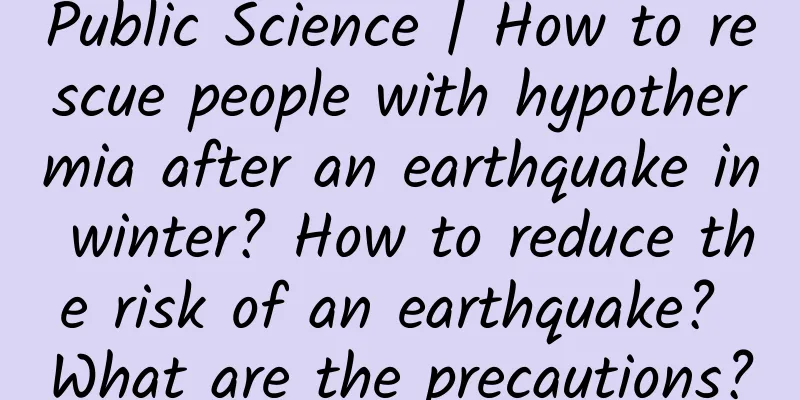Public Science | How to rescue people with hypothermia after an earthquake in winter? How to reduce the risk of an earthquake? What are the precautions?

|
At 23:59 on December 18, 2023, a magnitude 6.2 earthquake occurred in Jishishan Baoan, Dongxiang and Salar Autonomous County, Linxia Hui Autonomous Prefecture, Gansu Province. The focal depth was 10 kilometers. The epicenter, Liugou Township, was about 8 kilometers away from the county seat. The latest news shows: ① As of 15:00 yesterday, the rescue work in Gansu Province has basically ended , and the focus will shift to the treatment of the wounded and the resettlement of the affected people. ② Multiple departments have allocated 135,500 pieces of central disaster relief supplies to the disaster area, of which 66,000 pieces have arrived, 39,000 pieces are on the way (expected to arrive today), and 30,500 pieces have been loaded. ③ As of 9:00 today, the earthquake has caused 113 deaths and 782 injuries in Gansu , and all the injured have been admitted to the hospital. ④ Firefighters are using fixed-wing long-range drones equipped with infrared camera equipment to conduct large-scale and long-term aerial reconnaissance of the earthquake-stricken area in Dahejia Town to help post-disaster reconstruction. Although the relief work has basically ended, there is still some earthquake-related knowledge worth learning. Although you may not use it in your lifetime, these knowledge points may change your life or the life of others when they are used. 1. Prevent hypothermia! Since it is winter now and the outdoor temperature in Gansu is "below 0℃" , you must avoid exposure to low temperature environments as much as possible to prevent "hypothermia" or "frostbite", and find shelter or take warming measures as soon as possible. A. Victims of hypothermia are usually: a) Elderly people who do not have enough food, clothing or heating b) The baby sleeps in a cold bedroom c) People who spend a lot of time outdoors - homeless people, hikers, hunters, etc. d) Anyone who drinks alcohol or uses illegal drugs. B. The following are warning signs of hypothermia: a) Adults: i. Shiver ii. Exhausted or feeling very tired iii. Confusion iv. Clumsy v.Memory loss vi. unclear speech vii. Sleepiness b) Young children: i. Bright red, cold skin ii. Extremely low in calories 2. Help with hypothermia! If medical help is not immediately available, try to "warm up" the person: A. Get the injured into a warm room or shelter; B. Remove all wet clothing the person is wearing; C. If available, use an electric blanket to warm the core of the patient's body—chest, neck, head, and groin. You can also do skin-to-skin contact under a loose, dry blanket, clothing, towel, or sheet. D. Hot drinks can help raise body temperature, but "don't drink alcohol" and "don't try to give drinks to an unconscious person"; E. After the body temperature rises, keep the patient dry and wrap the body, including the head and neck, with a warm blanket; F. Get the person appropriate medical care as quickly as possible; G. People with severe hypothermia may lose consciousness and appear to have no pulse or breathing. In this case, move the person gently and seek emergency assistance immediately. Perform CPR even if the person appears dead . CPR should be continued until the person responds or medical help arrives. Continue to keep the person warm while performing CPR . In some cases, a hypothermic person who appears dead can be successfully resuscitated. 3. Deal with frostbite! If a person is showing signs of frostbite but "no signs of hypothermia" and "medical care is not immediately available," do the following: A. Get the injured person into a warm room as soon as possible; B. Unless absolutely necessary, do not walk on feet or toes that show signs of frostbite, as this will increase the risk of injury; C. Do not rub or massage the frostbitten area with snow, as this may cause greater damage; D. Place the frostbitten area in warm water, not hot water (the water temperature should be comfortable to the touch for unaffected areas of the body); E. If warm water is not available, use body heat to warm the affected area, such as using armpit heat to warm frostbitten fingers; F. Do not use heating pads, heat lamps, or heat from stoves, fireplaces, or radiators to keep warm; the affected area will become numb and can easily be burned. 4. Three principles of epicenter! Since aftershocks are still possible, if you experience an aftershock and are "sure that the building is safe" and are indoors, adhere to the three principles of "DROP, COVER, HOLD ON", get on all fours, find shelter (such as a table) to avoid falling objects, and protect your head and neck until the earthquake is over. 5. Get to safety! Although "staying as still as possible" is a priority principle during an earthquake, if the environment you are in is dangerous (such as cracked walls, unusual noises in the house, etc.), you should leave the danger zone as soon as possible and go to a shelter or open environment, but you should also pay attention to avoiding hypothermia in winter. 6. Get other people’s attention! If you are trapped, please give up the useless "subtlety" and do two things: A. Try to attract other people's attention. Send text messages, knock on walls or pipes, etc. to make noise to help rescuers find you; B. Protect your mouth, nose and eyes from dust. 7. Avoid wound infection! The risk of trauma during and after an earthquake is high (for example, Clostridium tetani is present in the soil, and you may get infected from foot injuries while escaping), so you need to get first aid as soon as possible to help heal the wound and prevent infection. 8.Try to help others! Non-professionals may put themselves in danger when taking rescue measures, so when effective measures are unable to be taken, protect yourself, try to contact rescue, and provide encouragement to others if possible. 9. Avoid security risks! Even if your home or environment does not "look" like there are any major problems, you should still pay attention to whether there are problems such as electric leakage (to prevent electric shock), gas leakage (to prevent gas poisoning or explosion), water pollution and food spoilage (to avoid foodborne diseases), and insect pests (generally not so bad in winter). If there are any related problems, seek help from professionals as soon as possible. 10. Follow-up management of disaster situation! Studies have found that respiratory diseases increase after winter earthquakes. Therefore, non-drug intervention measures, diagnosis and treatment, vaccination, disinfection and other work can help reduce the risk of related diseases in disaster areas. I hope the number of victims won’t continue to increase! willing =Pill= Disclaimer: This article was created out of personal interest, only to help more ordinary people have a clearer understanding of vaccines. The content and views do not represent any organization, unit, or institution, and it has not accepted any form of sponsorship. All pictures are from public online platforms. If the content is incorrect, please do more self-criticism (not). |
<<: Fact check: Are "coughing up the flu" and "coughing up the coronavirus" similar? Fake!
>>: Will you grow nodules if you are often angry? The truth is...
Recommend
How to treat kidney problems in women
Both men and women may have kidney problems. Poor...
What fruits can't be eaten to promote ovulation
There are many taboos for women during their ovul...
How long after wisdom teeth removal can I get pregnant?
Wisdom teeth are the front teeth that grow out of...
Doctors remind you: Don't do liposuction, it's a waste of money and useless
Everyone loves beauty and wants a good figure. Af...
Symptoms of women with hot upper body and cold lower body
In today's daily life, it is very common for ...
Can pregnant women eat sunflower seeds?
Sunflower seeds are actually the seeds of sunflow...
What is the best water temperature for baking soda vaginal douche?
Many people think of using baking soda to rinse t...
How to add salt when making egg fried rice? Should I add salt first or later when making egg fried rice?
As we all know, egg fried rice is a common food. ...
Symptoms of blood stasis in girls
If you want your body to be comfortable, the Qi a...
Can pregnant women eat barbecued lamb skewers?
After pregnancy, the mother will immediately beco...
Is it okay to wear a waist corset after childbirth? Precautions for postpartum waist girdle
During pregnancy, a woman's body shape will c...
What kind of tea should women drink when they have upper body heat and lower body cold?
Traditional Chinese medicine believes that upper ...
Can I drink soy milk after giving birth? What are the precautions?
In addition to taking care of the baby after deli...
What should pregnant women do if their mouths get ulcerated?
If you find bubbles in your mouth or sores at the...
What should I do if I have severe pregnancy reactions?
For female friends, getting pregnant and having c...









